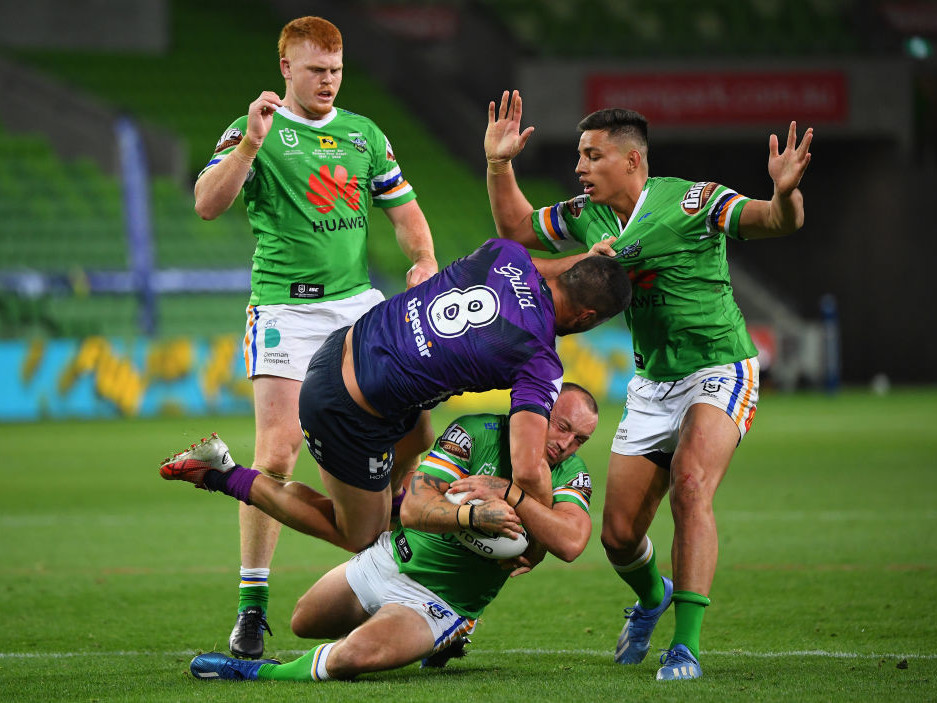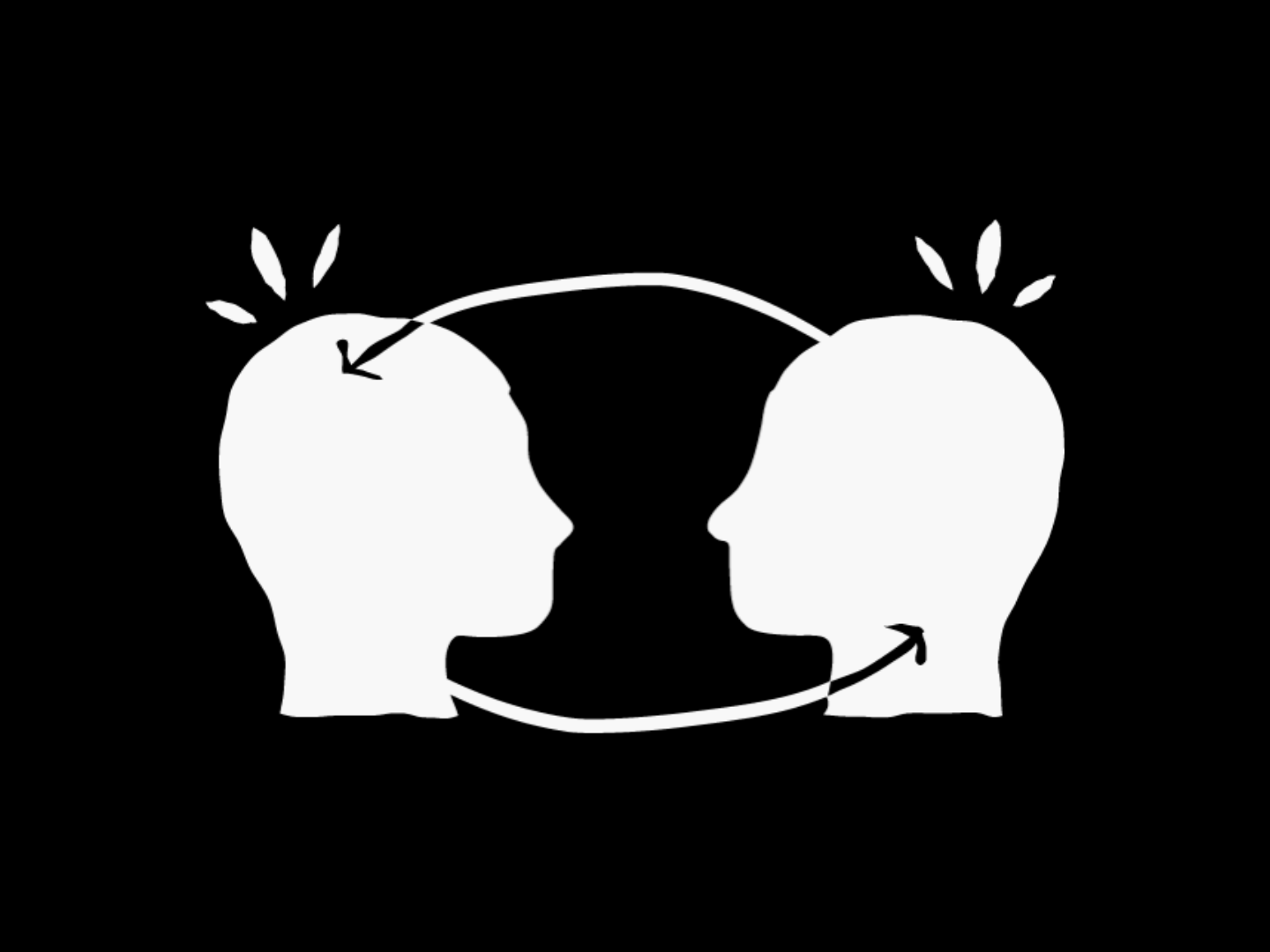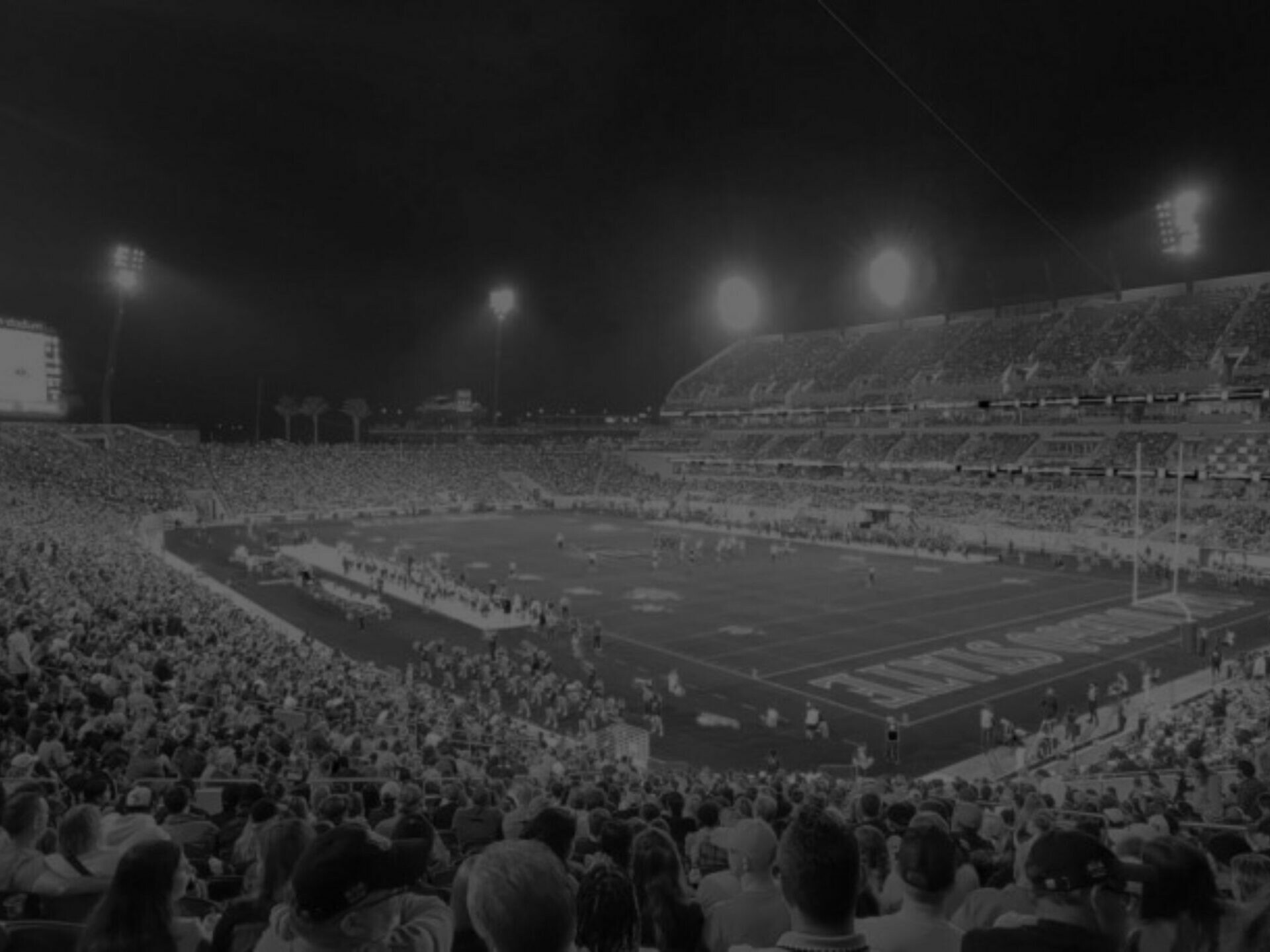In the second of a new series with Elite Performance Partners, Frank Ponissi of the Melbourne Storm and Matt Ford of the Canberra Raiders chart the day of their encounter as part of the NRL’s grand restart.
This article first appeared on the Leaders in Sport Performance Institute member’s site on Friday 5 June 2020
By John Portch with Dave Slemen
The Canberra Raiders travelled to the Melbourne Storm for the National Rugby League’s restart at the end of May.
The Raiders prevailed 22-6 to further burnish their Telstra Premiership credentials but the fact that the league was back in any shape or form was of greater significance than any single result.
“Did I, back in March, think we’d be back playing on 28 May? Hand on heart, no. I thought it would be too ambitious, too fast,” admitted the Storm’s General Manager Frank Ponissi.
The original 2020 NRL draw, which took place in November, pitted these teams against each other at the Storm’s AAMI Park in round 13 in early June.
That date was scratched from the calendar on 23 March when the NRL, moved by the pandemic, suspended play across the league after just two rounds and two weeks. The first round had been
played as normal and the second behind closed doors as Australia dealt with the spread of Covid-19. A little under 10 weeks later, the NRL became one of pro sport’s first mothballed leagues to return to action.
That process was described at great length by Storm General Manager Frank Ponissi, who spoke online to Dave Slemen of Elite Performance Partners [EPP], a search, selection and advisory firm
working across elite sport and specialising in performance, and the Leaders Performance Institute.
“I recommend teams have a plan A, a plan B and a plan C because you’ll need them all,” he added. “Planning for different scenarios is important and adaptability is the greatest quality you can have because things change regularly and you’ve got to go with it.”
In late-May, the revised draw was announced a schedule reduced from 25 rounds to 20. The Raiders’ encounter with the Storm was reinstated for the grand reopening weekend. Seven days later, the NRL and Victoria state authorities gave permission for the game to take place at AAMI Park behind closed doors. “It’s been a bit of a whirlwind,” added Ponissi.
The Melbourne General Manager is a friendly, engaging and insightful character, which is why EPP and the Leaders Performance Institute jumped at his offer to keep a performance diary on the day of the Raiders game. He even suggested enlisting his counterpart at Canberra, Matt Ford, who showed us equal generosity and graciousness in coming onboard for the idea.
“Like most clubs,” Ford tells us via email, “I am sure we have approached the travel and interruptions to normal game day processes with gratitude that we are back playing rugby league.”
On that note, both men have alluded to the newfound spirit of cooperation that exists between the 16 NRL teams. Ford adds: “To take this a step further we believe there may well be opportunities
that we look to implement post-Covid after being forced to re-think how we operate in and around games.”
The following is Ponissi and Ford’s accounts of Saturday 30 May.
Morning, Saturday 30 May
Frank Ponissi: Up to the time before we go to the stadium, there aren’t any major differences given that this is a home game for us. For all home games, we allow our players and staff to go straight from home to the stadium and we do not go into a hotel either the night before or the day of a home game. It differs for our away games, which are all interstate. The players will follow their normal routine in regards to when they wake up, eat, and have an afternoon nap. We encourage our players to have a normal preparation home and away regardless of if they are in a hotel or not. Given that there were no crowd allowed to watch the game, all the players and staff comment how they received no last-minute ticket requests. This is a plus.
1:00pm – Raiders depart from Canberra Airport
Matt Ford: Players and staff have to be at the charter plane hangar at Canberra Airport by 1:00pm. Upon arrival all players, staff and the match day referees have their health assessment checks
(temperature recording etc.) Once the health test was passed, the travelling party could walk onto the tarmac and board the 80-seat charter plane.
The seamless air travel logistics are much preferred to the traditional domestic flight scenario. The ability to arrive much closer to departure as well as our gear van being able to drive directly onto the tarmac are much easier than the usual check-in process. Likewise on the return flight, players and staff are in their car with their backpack five minutes after landing.
No food/drinks are served, however, we each have the option to bring something along. Upon landing in Melbourne, a coach pulled up on the tarmac adjacent to the aircraft and all the team gear
was loaded within ten minutes.
FP: Whilst we do not have to travel for another two weeks [to take on the Newcastle Knights on 13 June], we are already planning ahead to that first away game and we have staff talking to other clubs who did travel to get any advice.
3:30pm – Raiders arrive at AAMI Park
MF: After a 30-minute trip by coach, we arrive at AAMI Park to a ‘pre-game corporate space’. These spaces are standardised at each playing venue across the NRL to include three massage tables, TVs, an area for dining, Wi-Fi, and couches.
The major consideration at this point is adequately planning this two hours of ‘dead’ time prior to the squad entering the change rooms. This time is locked in by the NRL as contingency time in the event of a flight delay etc. but does make for a long period when players would otherwise be in the hotel relaxing/sleeping etc.
Given our normal preparation in the change rooms commences two hours before kick-off, we used the corporate space to relax for two hours prior to transferring to the change rooms. Our plan was to have food catering as close to what ‘normal’ would be in terms of quantity/quality if we were at a hotel for the pre-game meal. We have an internal tradition on game day where the players enjoy a coffee together. Although this normally coincides with their team walk, we pre-ordered coffees at the stadium so they were ready upon arrival. This was an effort to keep the game day experience as normal as possible where we could.
Aside from this, there was an opportunity for our two physios and a massage therapist to provide treatment during this time following the travel we had just endured. Other recovery modalities such as Normatec recovery boots were utilised. Fingers crossed we believe these interventions will be successful in reducing injuries. That being said, we are about to endure another six weeks of travel, including 3.5-hour bus journeys on the day of the game, as we do not have any ‘home’ matches in Canberra (these have been temporarily moved to Sydney).
FP: Whilst fierce competitors on the field there is a genuine high level of good spirit and cooperation between clubs at the moment so we all want to help each other given the unusual
circumstances of travelling up and back on game days. In the past clubs wouldn’t be as accommodating!
3:30pm-4:30pm – ‘Clean area’ prepared
FP: The ‘clean area’ [the change rooms and the player corridor] are deep cleaned for an hour. Broadcasters must also be set up no more than four hours before kick-off.
MF: Given the tight timing for access to the change rooms our gear steward required the assistance of another four staff to set up in the one hour prior to players arriving in the change rooms. Given we do not have a media staff member travelling with the squad I assumed the media coordination duties for game day. Thankfully we are still travelling with the same personnel we would normally so all other roles remained close to the same.
4:30pm-5:30pm – Storm players go through the NRL assessment point / enter the change rooms
FP: Players entered the stadium at a different entrance than they normally would, as they had to go through a central NRL assessment point. Whilst this may not seem too challenging, players are
creatures of habit. We also planned for our players to come in slightly earlier than normal given the protocols and that there was only one assessment point.
During the week, communication and education regarding game day was absolutely paramount. We didn’t want any surprises on game day. We erred on over-communicating to ensure that everyone was totally aware. Even little things like educating the players on not having earphones or hoodies before the assessment tests as these raise your temperature. We have pushed the theme of adaptability for a number of weeks.
The Raiders and ourselves had co-ordinated arrival times to avoid a bottleneck at the assessment point.
The other factor was the stress on the players and staff; that they were going to be temperature tested on arrival and, if they failed to be below 37.3 twice within 15 minutes, they would not be
allowed in and therefore ruled out. I had a player call me earlier in the afternoon who felt fine but had tested slightly above in the morning. These are stresses that players usually don’t experience.
Once the players passed through, nothing really changed too much from normal except comments about how many normal game day staff were not there. Each club is allowed 13 staff on game day.
5:30pm-5:45pm – Raiders go through the NRL assessment point / enter change rooms
MF: For the two hours in the change rooms prior to kick-off and then the game itself, most operational things were normal.
7:35pm – Kick-off
MF: The competition has moved to a one-referee system for the remainder of this season and that is to be reviewed for 2021 and beyond. This decision was in part a financial decision by the league due to Covid.
The stadium is also less daunting in terms of the atmosphere provided in-game.
FP: Games are both more or less daunting without crowds. We really enjoy our home support at AAMI Park but we also love playing at intimidating away venues.
In terms of injuries, I don’t think anything in particular from this game or any given game will be any different. However, it’s the cumulative effect of travelling up/back on one day, and the fact that the NRL have made some key law changes, which has sped up the game, will all have an effect over a period of time. That will come down to recovery and training workloads in weeks to come. Our other issue is that the players currently not selected to play don’t have the opportunity to play in lower leagues as they usually do so when they do eventually play they will be at a higher risk.
9:30pm – Full-time
FP: The Raiders certainly adapted better than we did in reacting to the lack of atmosphere on game night given no crowds. They had a fast start going to a 12-0 early lead which proved significant in the end.
MF: Post-game presented a challenge when we were notified that we may not be able to fly back into Canberra that evening due to fog. A contingency plan had been made to leave the stadium
ASAP after full-time and possibly fly to Wagga Wagga, which would leave us with with 2.5-hour bus trip to Canberra, or Sydney, which meant a 3.5-hour drive back.
10:00pm – Raiders leave the stadium
MF: Thankfully, in the end we were allowed to fly into Canberra.
10:30pm – Storm players leave the stadium
FP: Post game, the players and staff left the stadium much earlier than a normal home game given the reduced commitments. That allowed them to start their recovery quicker.
11:00pm – Storm staff leave the stadium
FP: Now that we have been through round 3 and we know what to expect, we will pull back talking about the processes and logistics of the new match day protocols. It’s now a case of ‘just get on with it!’
With regards to performance on the field, the players have definitely learnt some valuable lessons in adapting to the vastly different surrounds. Whilst we still have one more home game [Friday 5 June vs South Sydney Rabbitohs] before we are required to travel, we were fortunate that we travelled to the Cronulla Sharks on the day of the game for round 2 back in March before Covid-19 stopped the competition. Given that we won that day, behind closed doors, that will give us a lot of confidence.
12:10am – Raiders land at Canberra Airport
MF: Had we been diverted we would likely have arrived home via coach at 4 or 5am. We are striving for consistency in how we approach our travel. We are also conscious that this is all very new to players/staff to have to deal with, so if we need to make any changes on the run we will. Our ultimate hope is that beyond round 9 (which the playing venues are currently scheduled until) we
resume playing in our home town of Canberra and, further to that, in front of crowds again before too long.
[mc4wp_form id=”1861”]
Related Posts
Building high-performance environments off the pitch in elite sport
September 28, 2023
0 Comments8 Minutes






Seems so long ago. The postscript to the story was that the Melbourne Storm went on to win the Premiership in 2020. Not long after this interview, the whole club moved out of Melbourne to be based on the Sunshine Coast in Queensland for the rest of the season due to lockdown restrictions in Victoria. So while a winter in Queensland, living 200m from a beautiful beach, might sound preferential to a bleak Melbourne winter, the whole club spent 6 months away from their homes and family networks.
Strangest season ever. Proudly, that’s my son in the 8 jersey!